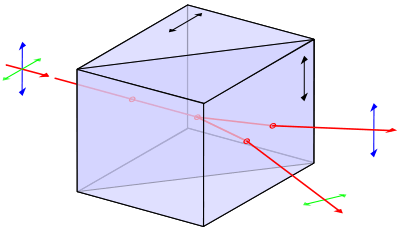Wollaston prism

A Wollaston prism is an optical device, invented by William Hyde Wollaston, that manipulates polarized light. It separates randomly polarized or unpolarized light into two orthogonal linearly polarized outgoing beams.
The Wollaston prism consists of two orthogonal calcite prisms, cemented together on their base (traditionally with Canada balsam) to form two right triangle prisms with perpendicular optic axes. Outgoing light beams diverge from the prism, giving two polarized rays, with the angle of divergence determined by the prisms' wedge angle and the wavelength of the light. Commercial prisms are available with divergence angles from 15° to about 45°.
See also
- Nomarski prism
- Nicol prism
- Glan–Thompson prism
- Glan–Foucault prism
- Glan–Taylor prism
- Sénarmont prism
- Rochon prism
References
- "Wollaston prism". AMS Glossary. Retrieved 2013-04-29.
- "Molecular Expressions Microscopy Primer: Specialized Microscopy Techniques - Wollaston Prisms: Interactive Java Tutorial". Florida State University. Retrieved 25 May 2010.
This article is issued from Wikipedia - version of the 9/18/2016. The text is available under the Creative Commons Attribution/Share Alike but additional terms may apply for the media files.